A Game Jam in the Middle of the Atlantic Forest?? Bird Game Jam – Legado das Águas
- Livia Scienza

- 2 de ago.
- 9 min de leitura
Atualizado: 3 de ago.
Birds of a feather stick together! Get to know how owl these game devs made bird games as fast as a hummingbird's wing flap!

I should probably tell you a secret. I've never been part of a game jam as a participant before. I've been a judge, mentor and even conflict mediator. This time, however, I got the job done with an AMAZING team (seriously, I'm their biggest fan). I also worked as a journalist and as an amateur photographer since Controles Voadores does not play on easy mode. All the pictures that you'll see in this article were taken by this little one writing to you.
In my first game jam as a participant I went to... Guess where? To the middle of the Atlantic Forest! "Say whaaat? What could game devs be doing in the middle of the forest?" Well, that's a great question!
The answer to this question lies in one word: IMMERSION. The Bird Game Jam, in it's last edition, was all about flying together with birds with the help of specialists biologists and skilled mentors. Want a spoiler? The team behind the jam really got the game going! They were awesome! I'd like to give a shout out and express my gratitude to the team responsible for all the planning and execution of the jam.
Off the record: I was SO excited when I knew my registration was accepted that I made a playlist with techno songs with nature and bird sounds to get me inspired (if you're into it, check it out).
Legado das Águas' Structure
The path to the reserve was an adventure in itself. All participants met at the Tietê bus station to take two minivans. The road was smooth.... Until it wasn't. The dirt road provided us with lots of laughter as our heads hit the minivan's seats with the chaotic movement. We looked like a bag of popping popcorn. But it was worth it, you know?
For a jam, structure is essential. Legado das Águas is the Atlantic Forest preservation reserve that sheltered us for 4 days. The inn has numerous houses with several rooms and beds. Participants and their mentors were divided into houses: 2 teams of three people each.
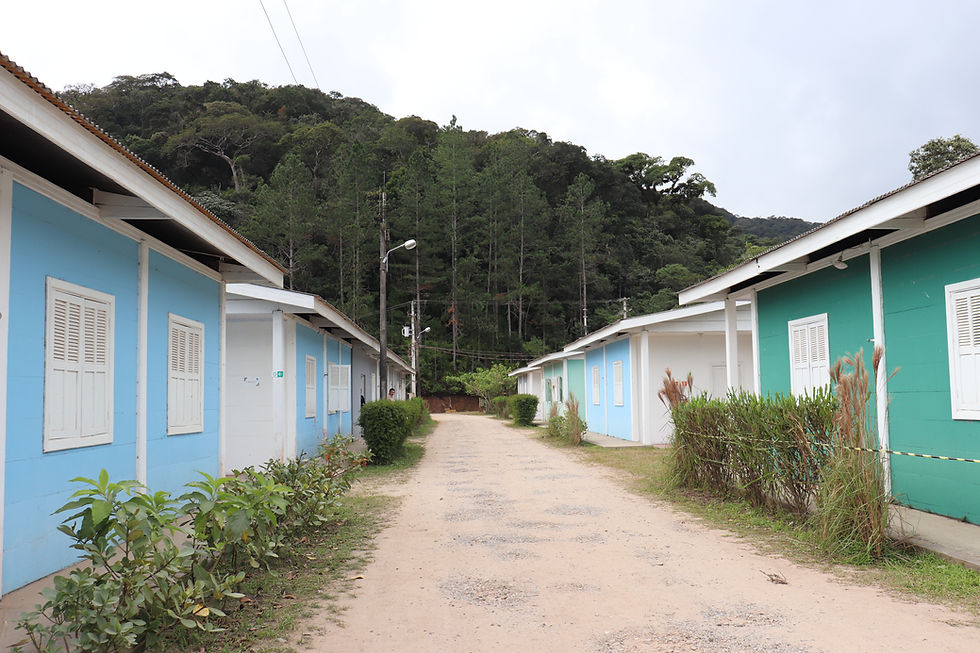
I confess that I went to the jam with no expectations (in the sense of not thinking too much about what it would be like, but I imagined it would be a lot of fun). After all, the organization was very emphatic in asking us countless times if we really wanted to go (there are many risks in venturing into the forest, aren't there?).
We came to the jam at the end of July, facing a cold 13 degrees celsius. We had, however, access to microfiber blankets, duvets, pillows, and towels. What else could we need?? Well, we also had included meals and guided morning and evening walks. The quality of all this surprised me so much that I didn't want to leave.

During our guided walks it rained lightly. But even that wasn't enough to dampen the enthusiasm of the group in asking the guide several questions about the fauna and flora. We saw tapir tracks, heard countless birdsongs and spotted monkeys feeding on palm trees.

But what about access to energy and internet? Have you ever thought about a jam without internet? We also had that covered! That's right, baby! Internet in the forest!
The Jam itself was held in a spacious auditorium (and very very colorful like the little birdies) with several tables distributed for the groups. Each table had a power strip. The first day, we had some problems with the internet. Participants had to use the internet in the cafeteria. However, this was soon resolved. The organization made it clear in the instructions that the internet should be used to download smaller assets and to upload the finished game.

In this case, heavier software and other tools should have been downloaded before we arrived at the inn. A group was created on a chatting app and participants, mentors and organizers gave each other tips on what to download before the venture.
Decompression Space
Anyone who has read some of my articles knows that I am autistic and have ADHD and that I usually comment a little on accessibility issues for ASD.
Already on the registration form, the organization asked if the participant was a person with disabilities and if they needed any type of support. In addition to bringing my Ritalins pals, I made it clear that it would be great to have a quieter space (although I always carry my noise-canceling headphones).
The organization was very attentive in this regard. As soon as we arrived, they made a point of showing us the decompression area: a museum room with seating spots, cool and quiet.
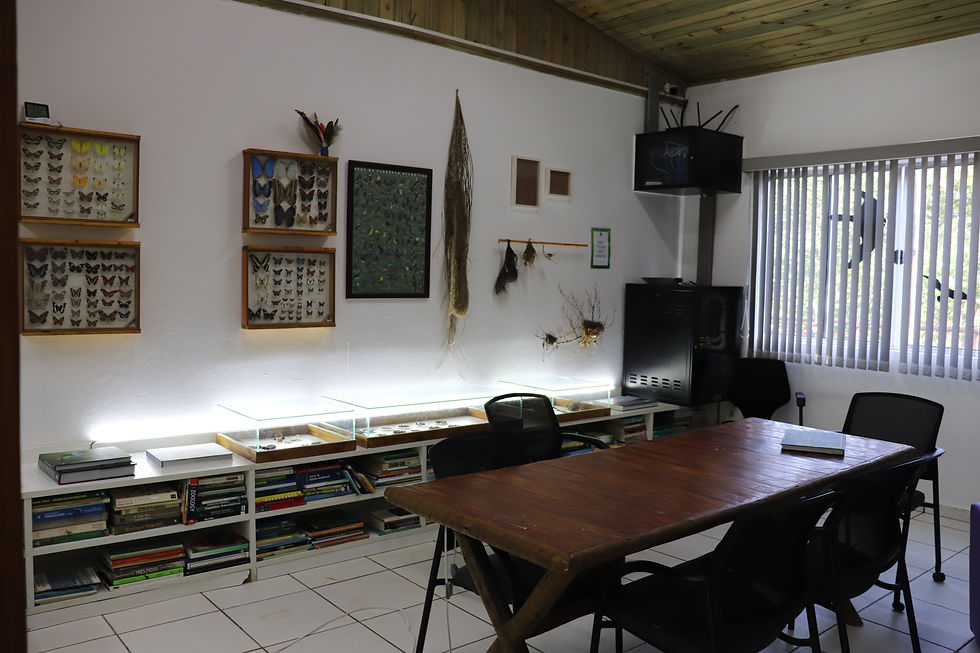
I didn't particularly have to resort to it, but I might have needed to. Since the jam allowed us to move around freely, when I felt a little overwhelmed I would just go for a walk or sit in a place with fewer people.
We were also asked about allergies and other issues like food intolerances and our blood type. When we arrived, we had to sign some terms regarding our own safety.
Specialized Mentors
In addition to the wonderful art, music, programming, and UI/UX mentors, we had mentors who are experts in birds, such as science communicator Ju dos Passarinhos, who has over 70,000 followers on Instagram.

We had a multitude of materials at our disposal, in addition to the environment completely surrounded by specimens of fauna and flora. I was sure of bringing my camera to take lots of photos to use as reference and to keep them close to my heart.
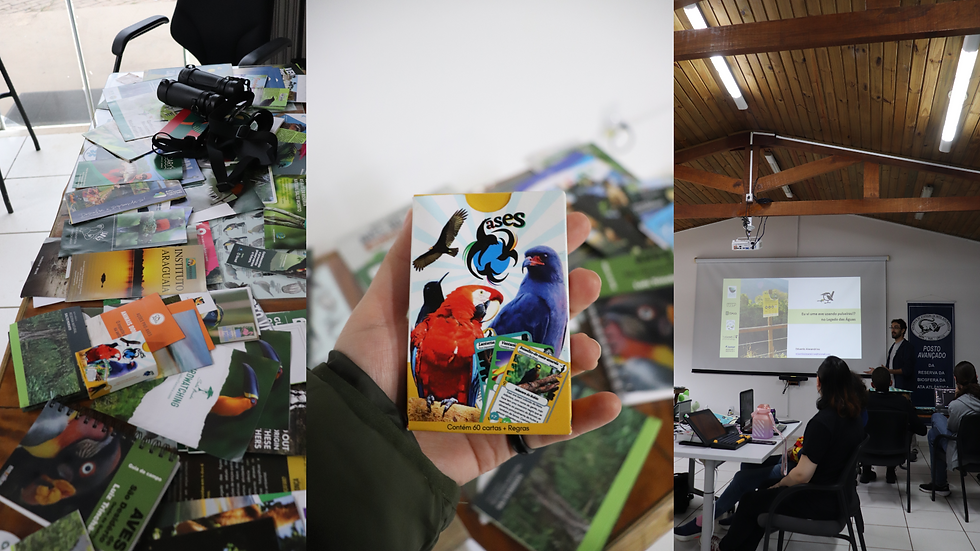
Scientific Research of the Reserve
Various preservation research projects are conducted at the Legado da Águas Reserve. Participants had the privilege of meeting some of them up close, listening to researchers passionately share their academic adventures.
Two of them are researcher Eduardo Alexandrino and researcher Taynara Cristine Bessi, who have been investigating the impact of feeders exposed to the open air on the habits of local birds for years.
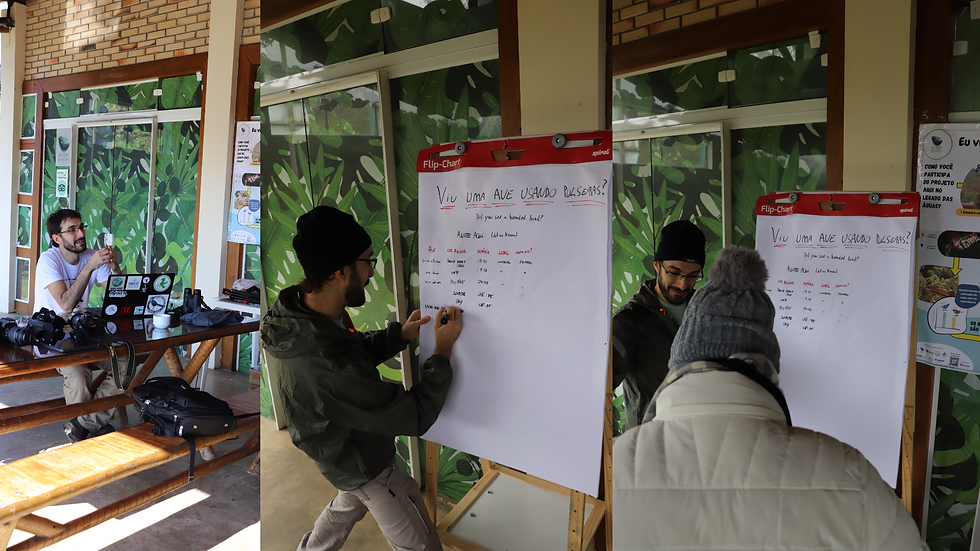
Eduardo told us how research on the impacts of feeders is still scarce here in Brazil and that much of the data comes from North America. To study the specimens, individuals are banded (wearing bracelets) with different colors to be identified over time. Visitors to the reserve can take photos of these individuals and complete forms to assist in the project called Citizen Science. The study of these birds was titled "Birds Wearing Bracelets?!".

Another preservation research project in the Reserve is the maintenance of flora species. When visiting Legado das Águas, you can buy examples of the native elements of the Forest. I myself couldn't contain myself when I heard the narrative lore of one of the species and had to bring one with me. This is a species of orchid that, according to the guide, had not been found in the State of São Paulo for 70 years. When they found seedlings, the Reserve began to cultivate them and then return them to nature.

The Routine
Many of the participants stayed up all night and didn't sleep at all. Others chose to rest more in the early morning, going to sleep. I myself turned the day twice. Since it was a slightly longer jam than most, it was possible to work hard, but also to talk, exchange ideas, appreciate the beauty of the place and rest between work sessions.
We had pre-established schedules for all organized activities such as walks, meals in the cafeteria and lectures. In this edition of the jam, mentors were also participants. Each team had a mentor and two other participants. However, many of the mentors walked between the tables offering assistance or having been called upon to evaluate some aspect of the games being created.

During the night, from 8pm onwards, we had coffee available. Between meals, many of us snack on the little things we brought to the jam. Since I'm a gym bro (not really nope), I took several protein bars. I didn't drink coffee that much (but I ate way too much because the food was unmatched).
Participants sometimes took their notebooks, illustration tables or MIDIs (Musical Instrument Digital Interface) and went to other places to seek inspiration.
Many chose to work near the feeder, a place where many birds passed by all the time. Others still used creativity to create their work environments, such as using a made-up "standing desk".
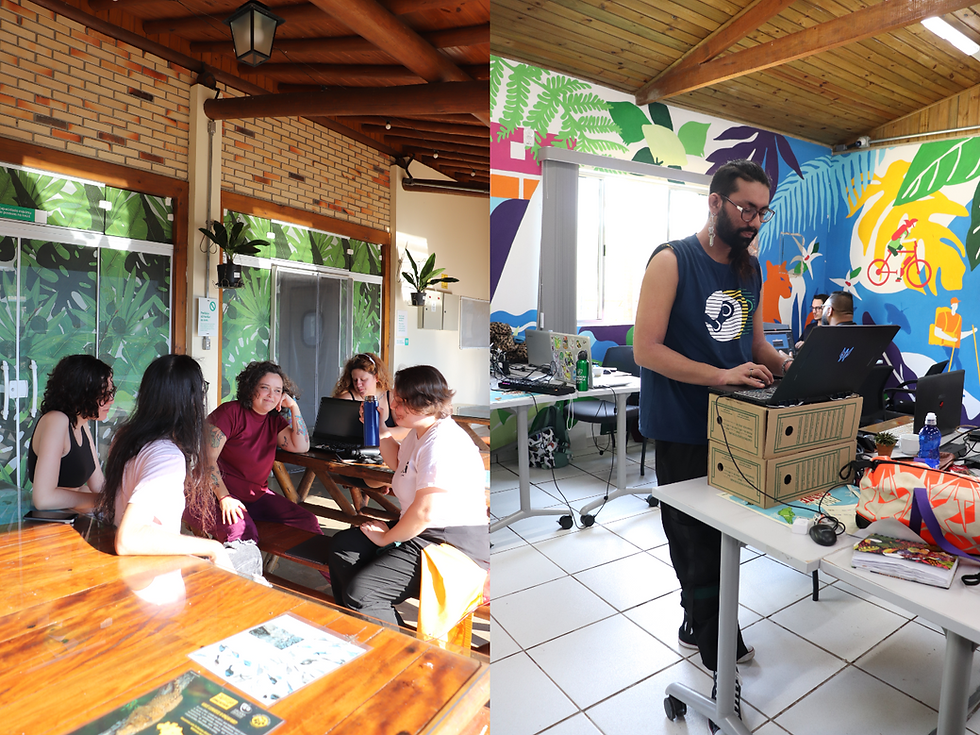
Games Presentation
Sunday morning started slowly. Many of the participants chose to sleep and rest until later. Some had already finished their games and just needed to polish them. Others chose to stay up all night and didn't even sleep.
In the early hours of Saturday to Sunday, some of the participants held a kind of improvised "happy hour", with beer and even wine. It was a moment of relaxation before the big day of the final presentation of the games. Presentations were made informally between teams throughout the jam. Every now and then a biologist from the Reserve would also show up to see how the games were going.
One of the biologists on the Reserve team (already mentioned here), Eduardo, almost cried when he saw some of the games that cover his study. Participants told him that it is one of the ways to give back for all the work he does. Eduardooo if you are reading this, you're the man! This is one of the rewards of creating science outreach games that value the work and studies of serious scientists. Often these heroes don't get the credit they deserve.

It is worth noting that the atmosphere throughout the jam was one of great camaraderie and mutual assistance. Words of affirmation could be heard throughout, with participants praising the work of colleagues from other teams and their own teams. During the presentation of the finished games, the same vibe could be felt. Everyone was genuinely very impressed with the work.
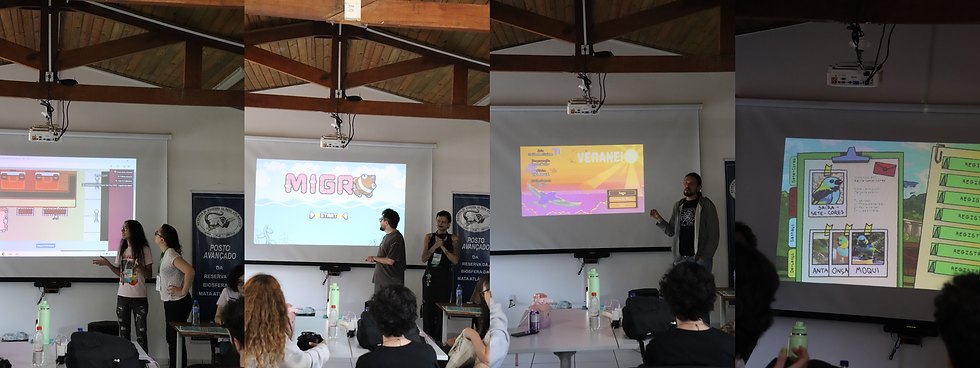
The level of programming, music, art, modeling and game design in this final edition of the jam was very high. After all, practically all participants already have experience with development (some within very known studios in Brazil).
It was 4 days (from July 24th to 27th) of a lot of learning, fun and serious development. In addition to creating games, we had classes on fauna and flora.

Who knows, maybe in a future article I'll tell you specifically about how we created our game "Legado das Aves"?
Our team was made up of PHENOMENAL programmer Mila Milanese from Miris Arcana and STRONG mentor artist Vic Motta from Vortex.
[I urge you to go and search immediately for the game Le Fol and the game Turi-Kaapora and add them to your Steam wishlist]
As usual, many jam participants end up learning new skills throughout the marathon or improving the ones they already have.
In my case, I worked on creating not only the UX flow, but also the UI. And you know what? I LOVED it! Mila, from our team, also learned how to implement UI in Unity and said she loved it!
I was prepared to make music from scratch, but unfortunately there wouldn't be enough time. Knowing how to define the scope of the project is also part of being a dev, right? In this regard, I learned a lot in this jam.
Also, be sure to check out all the games from all editions!
I hope, from the bottom of my heart, that more jams can align themselves with scientific outreach and can be inspired by the organization's PHENOMENAL initiative. Bird Game Jam was built by many hands and had a wonderful design that took months to create. It deserves a standing ovation! It became the boss of all jams and other jams will have to fly very high to reach this edition.
My gratitude to everyone involved. Writing this article is an honor.
To finish, I'll leave here this photo I took of two banana araçari :) (NOW I KNOW THE NAMES OF SEVERAL BIRDS HHHMKAY?). Stay tuned because I'll be back!
An article about each of the games developed in this edition is already in the making!











Comentários